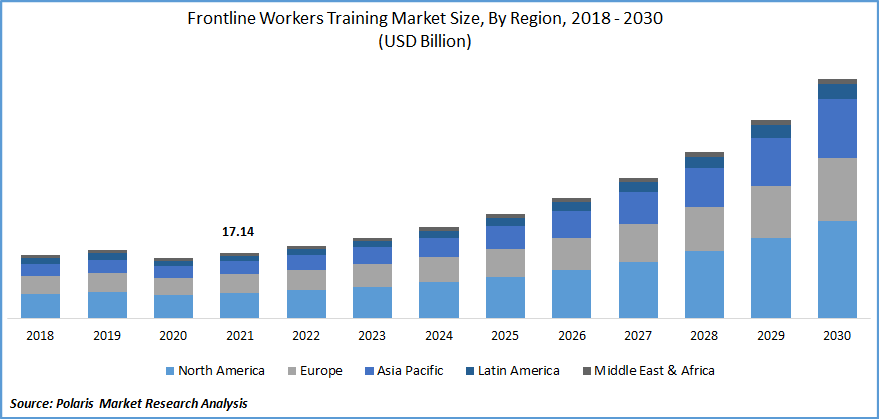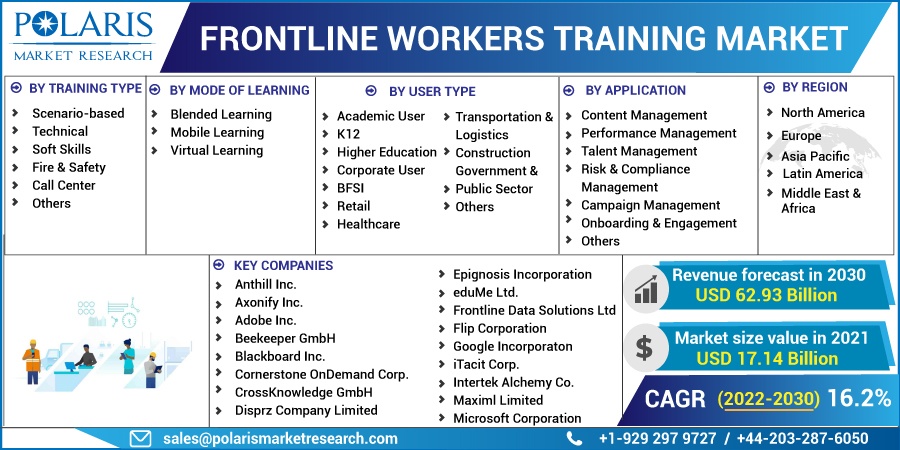
Frontline Workers Training Market Share, Size, Trends, Industry Analysis Report, By Training Type (Scenario-based, Technical, Soft Skills, Fire & Safety, Call Center, Others); By Application; By User Type; By Solution; By Mode of Learning; By Region; Segment Forecast, 2022 - 2030
- Published Date:Oct-2022
- Pages: 114
- Format: PDF
- Report ID: PM2688
- Base Year: 2021
- Historical Data: 2018-2020
Report Outlook
The global frontline workers training market was valued at USD 17.14 billion in 2021 and is expected to grow at a CAGR of 16.2% during the forecast period. Frontline training refers to programs and initiatives that train frontline workers in healthcare, education, supermarket and retail, hotel management, etc.

Know more about this report: Request for sample pages
Frontline workers frequently work long hours, often without the benefit of an office or a computer, and face additional challenges, such as a shortage of resources and work-related uncertainty. Frontline training is essential because it is an enterprise's customer support foundation. Frontline employees have a significant impact on the business brand among customers. Positive customer care experiences can help to bring in new customers and increase revenue.
Learning institutions have indeed been compelled to undertake classes online because of global lockdowns caused by the spreading of the COVID-19 virus. As a result, educational institutions and businesses have increased their demand for digital learning platforms, resulting in investment opportunities in frontline training solutions.
For example, when the Indian educational tech company BYJU'S revealed unlimited access to its software program developed in March, it saw a 150% rise in the number of new students. Between March and April, the system attracted over 13.5 million new students. With social isolation and school closures on the rise, online education has become a crucial component of the curriculum.
While COVID is still widely used worldwide, many businesses find it difficult to provide one of the best beneficial forms of scenario-based training, such as real-world experiences. It is critical to provide a rigorous curriculum that can provide staff members with real-life scenario training, particularly for frontline workers. As a result, virtual learning enables businesses to develop standardized documents, audio, and videos to ensure that all employees understand proper safety procedures.
Many organizations across industries rely on undeniable frontline worker training and advancement initiatives and already have detailed frontline employee training and improvement content that is difficult to convert into microcontent. Efforts worldwide are debating whether or not to spend a fortune converting their current frontline worker teaching materials into microcontent, which could be time-consuming and expensive.
Furthermore, consuming existing frontline worker instructional content in a microlearning setup may not be sufficient to meet the needs of a frontline worker training and improvement program. To effectively carry out microlearning-based frontline worker training, the organization may need to build teaching materials without prior preparation, which can be costly.
The COVID-19 crisis is wreaking havoc on workers and employers across the board. Workers in critical services such as health care and frontline emergency response are particularly vulnerable to infection. Grocery workers, airline staff, and autoworkers are among those whose health and livelihoods have been jeopardized by the pandemic.
Many member countries are taking unprecedented steps to protect frontline workers while minimizing the impact on businesses, livelihood opportunities, and the more vulnerable members of society. The government has increased investment in secure and decent workplace conditions for frontline workers to ensure that this global epidemic does not have long-term ramifications for economic systems, people, and jobs.
 Know more about this report: Request for sample pages
Know more about this report: Request for sample pages
Industry Dynamics
Growth Drivers
Rapidly rising government investment in training platforms for frontline workers boosts the market growth over the forecast period. For instance, in April 2020, The Government of India launched a training program for COVID-19 management called the 'Integrated Government Online Training' (iGOT) platform on the MHRD's DIKSHA system. The portal aims to increase frontline workers' ability to cope with the pandemic effectively. More than one crore teachers and students in 30 states and UTs are already using the MHRD's DIKSHA Channel.
Furthermore, in June 2021, Underneath the Skill India scheme, the Government of India launched six customized Crash Course programs for Covid-19 frontline workers via teleconferencing. According to the government, it will open 111 training centers across 26 states as part of the Customisable Crash Course program. Thus, this investment in the training program and training courses for frontline workers drives market growth over the forecast period.
Report Segmentation
The market is primarily segmented based on solution, mode of learning, training type, user type, application, and region.
|
By Training Type |
By Mode of Learning |
By User Type |
By Application |
By Region |
|
|
|
|
|
Know more about this report: Request for sample pages
Mobile Learning segment is expected to witness the fastest growth
The mobile learning method is anticipated to witness significant growth during the forecast period. Increasing smartphone usage and the ease of information exchange provided by consistent messages transmitted immediately to the frontline via a mobile learning system will propel the market expansion of mobile learning mode. Frontline training alternatives with mobile learning methods provide frontline workers in small villages who experience similar communication bandwidth issues with practical education tools to handle work off-site.
Mobile is a convenient device for quickly getting educational materials to people at work. It needs to meet them right at the beginning of their workday. They can learn at their speed due to mobile learning. Furthermore, they can download and availability the learning materials offline. Mobile learning offers a wide range of learning opportunities to frontline workers, increasing their productivity and enhancing their implementing effective of where they are. They can conveniently use their free time while traveling or waiting for a customer to learn something new.
The solutions segment industry accounted for the highest market share in 2021
During the forecast period, the solutions segment is expected to have the largest market size. These solutions assist businesses in upskilling their workforce by utilizing a single online learning platform. Providers of frontline worker training courses compete to broaden their market coverage and existence in newer markets.
Blended Training is expected to hold the significant revenue share
Blended learning could indeed aid in an individual's overall development. A good classroom and self-paced learning mix can help frontline workers improve their skills. Disprz, a blended platform, has various benefits for frontline workers. Disprz offers suggestions to frontline personnel at multiple levels as an AI-powered learning solution. So they can look into the topics that interest them.
Individuals can also have multiple formats on a single platform. A frontline worker, for instance, could watch a video, read a blog, listen to a podcast, and afterward take an assessment. Furthermore, the majority of the frontline team lacks adequate bandwidth. As a result, they can download and access content offline.
Workers can use blended learning to explore information that interests them. Workers, for example, could watch a video, read a blog, listen to a podcast, and afterward take an assessment. Furthermore, most frontline workers do not have enough bandwidth. As a result, they prefer simple offline information access and download alternatives to obtain better content.
The demand in North America is expected to witness significant growth
North America is an innovative company due to its early adoption of modern technologies. It is anticipated to present an excellent opportunity for frontline worker training distributors to broaden this market. Frontline employees in North America bravely reported for work and decided to risk their mental well-being to maintain the economy moving and the majority of the population secure.
During the forecast period, North America is expected to influence the market. The growing interest in frontline training between many new companies and the advancement of eLearning technology in critical areas would encourage the district's market growth. The ever increasing significance of eLearning and versatile training methods in various economies, such as the United States and Canada, will drive market development in the region.
The Asia Pacific market is predicted to expand at the fastest CAGR during the forecast period due to the region's rapid urbanization and industrialization and government assistance for accepting deskless technology. The requirement for workforce development skills by companies throughout major corporate customers such as BFSI, health services, hospitality, and department stores is anticipated to contribute to the development of the Asia Pacific market.
Competitive Insight
Some of the major players operating in the global market include Anthill Inc., Axonify Inc., Adobe Inc., Beekeeper GmbH, Blackboard Inc., Cornerstone OnDemand Corp., CrossKnowledge GmbH, Disprz Company Limited, Epignosis Incorporation, eduMe Ltd., Frontline Data Solutions Limited, Flip Corporation, Google Incorporation, iTacit Corp., Intertek Alchemy Co., Maximl Limited, Microsoft Corporation, Oracle Corp., Orion Labs Inc., Opus Training Center Incorporation, PTC Inc., Rallyware, Inc., Skyllful Corporation, Skedulo Inc., and YOOBIC Ltd.
Recent Developments
- In June 2022, Axonify, a pioneer in frontline staff training and communication systems, announced the purchase of Nudge, the leading employee communication, and implementation platform. This strategic partnership will streamline frontline team deployment and provide best-in-class tools for frontline-focused organizations.
- In June 2022, YOOBIC, the innovative enterprise technology producer trusted by 300+ international corporations, announced a collaboration with OpenSesame, to provide strong opportunities for training and growth for frontline teams. The businesses will collaborate to provide employees with in-workflow connectivity to over 25,000 digitally optimized training courses in crucial aspects such as mental health, well-being, diversity, and workplace safety.
Frontline Workers Training Market Report Scope
|
Report Attributes |
Details |
|
Market size value in 2022 |
USD 18.91 billion |
|
Revenue forecast in 2030 |
USD 62.93 billion |
|
CAGR |
16.2% from 2022 - 2030 |
|
Base year |
2021 |
|
Historical data |
2018 - 2020 |
|
Forecast period |
2022 - 2030 |
|
Quantitative units |
Revenue in USD billion and CAGR from 2022 to 2030 |
|
Segments Covered |
By Training Type, By Mode of Learning, By User Type, By Application, By Region |
|
Regional scope |
North America, Europe, Asia Pacific, Latin America; Middle East & Africa |
|
Key Companies |
Anthill Inc., Axonify Inc., Adobe Inc., Beekeeper GmbH, Blackboard Inc., Cornerstone OnDemand Corp., CrossKnowledge GmbH, Disprz Company Limited, Epignosis Incorporation, eduMe Ltd., Frontline Data Solutions Limited, Flip Corporation, Google Incorporaton, iTacit Corp., Intertek Alchemy Co., Maximl Limited, Microsoft Corporation, Oracle Corp., Orion Labs Inc., Opus Training Center Incorporation, PTC Inc., Rallyware, Inc., Skyllful Corporation, Skedulo Inc., and YOOBIC Ltd. |
